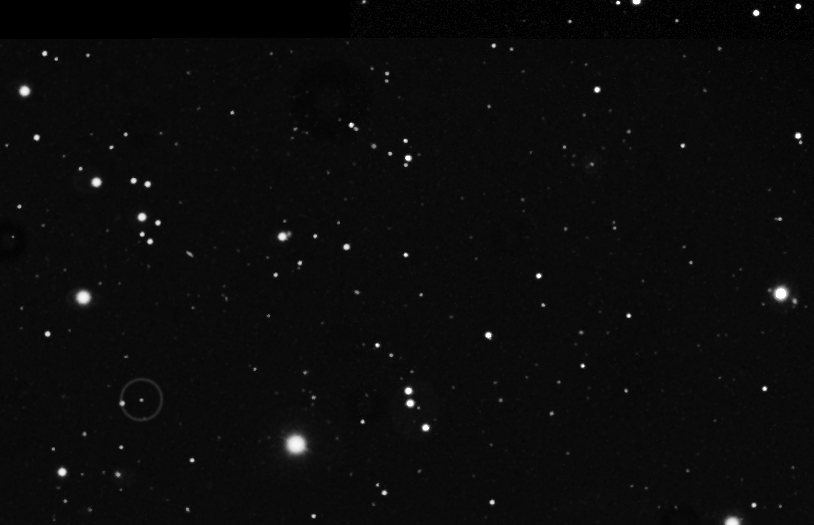Object name: ERIS Eris is a dwarf planet that is almost as large as Pluto and much farther away. In fact, it is the most distant object known to be orbiting in our solar system. Space probes like Voyager 1 and 2 are even farther away but aren't orbiting. Sedna can get farther from the Sun than Eris but currently is closer. So Eris currently marks the most distant known object in our solar system, about 3 times the distance of Pluto right now. The image I ran was cropped from a much larger image. That turned out useful. On Jan 22 and 24 (all UTC) I reimaged Eris. When I compared the new images I realized I was seeing some of the same stars. In two months it had moved only a fraction of my field of view which is only about 34' wide. But I'd lost the original position just out of the frames on the left. Also since the temperature was 25C colder the image scale and distortions in the optics didn't match. RegiStar, however, was able to correct for all this as well as other problems and registered all three images nicely. I then combined these to make a three frame movie. I left the circle I'd drawn around Eris in the movie for all three frames. I should have circled the other two positions as well as it may be hard to find toward the upper right-hand corner (northwest corner). When I imaged Pluto several years ago it moved as far in two days as Xena - er Eris (I still prefer the rejected name) has in 2 months!
You will notice it has changed direction. While it is well west (right) of the first image it is moving up and to the left. It obviously had to have been moving right earlier. In fact, it was moving 0.0003" of arc per second due west when imaged in November. In January it was moving 0.0002" north and 0.0001" east per second. So the first jump from left to upper right took 2 months while the second jump is 2 days. Midway between it slowed to nearly being motionless before reversing direction. Those familiar with relative orbital motion will see that I've caught Eris at the turn around from retrograde to prograde (direct) motion. That is, in November we were rapidly passing Eris as we speed around our inner track about the sun while two months later we were mostly moving away from Eris so its forward motion is now being seen. Soon we will be going backwards on the opposite side of the sun from Eris and thus it will speed at a rather high rate eastward. I caught it at the turn around point so the motion was minimal. The northern motion is due to our orbits being tilted with respect to each other. Since Eris is so far away it is barely moving, most of the motion we see is due to the motion of the earth, not Eris. Here are a couple links on this subject for those who want to know more.
http://apod.nasa.gov/apod/ap011220.html
http://en.wikipedia.org/wiki/Retrograde_motion
The first shows a time lapse of Jupiter and Saturn moving over nearly a years time. The first go east (direct motion) then reverse to retrograde than back to direct again. My image covers only about 20 minutes of arc, the linked image covers about 40 degrees, 120 times wider than mine so the scale of motion for planets is much greater than that for distant Eris. The second link is a Wiki article on the subject.
For reasons lost to time, the initial image is 3 10 minute frames while the second is 6 three minute images and the third 7 2 minute images. All taken binned to 1.5" per pixel. Related Designation(s):ERIS, | | 